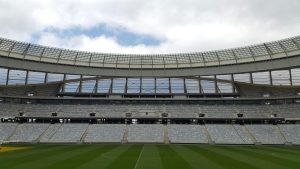Sports districts are emerging as powerful engines of urban development. Anchored by stadiums and arenas, these areas often feature a mix of residential, retail, and entertainment spaces, transforming the surrounding landscape.
It has significant implications for real estate investment and community development, making strategic planning vital to successful projects. From Atlanta’s multifaceted developments to Los Angeles’ expansive Hollywood Park, these districts aim to balance financial returns with community integration.

Table of Contents
Real Estate Implications: More Than Just Venues
The real estate impact of sports districts goes well beyond the construction of stadiums. A core strategy involves creating mixed-use spaces integrating various real estate products, such as office buildings, apartments, and retail spaces.
The Arlington Entertainment District in Texas, home to the Dallas Cowboys and Texas Rangers, has sparked around $1 billion in new development. It seamlessly blends commercial, dining, and hospitality spaces with sports venues, which some have termed a “better business district,” where people live, work, and play in one integrated environment.
Adding to its appeal, the Arlington District includes designated zones for live betting, making it particularly attractive for partnerships with betting platforms. These areas create a more engaging experience for fans and generate higher foot traffic for betting partners. Promotions like ESPN bet promo codes find a ready audience here, further enhancing the district’s economic potential.
Such developments require careful market analysis and land planning to determine the optimal use of adjacent areas. Developers often conduct feasibility studies to balance the density and scale of real estate products like hotels or multifamily housing, aiming for economic viability and alignment with community needs.
The goal is to optimize revenue streams through long-term leases, hospitality packages, or retail partnerships. Partnerships between sports franchises and real estate developers, like those seen with The Battery Atlanta or SoFi Stadium, exemplify the strategic alliances that fuel these transformations.
Community-Centric Design: Engaging the Public
The success of sports districts hinges on their ability to connect with local communities. Modern projects increasingly prioritize community-centric designs, ensuring spaces remain active even outside game days. For example, the Richmond Olympic Oval in Canada offers multipurpose spaces that host community meetings, sports, and recreational activities year-round.
Strategically designed spaces around these venues often include parks, public plazas, and walkable retail areas, making them inviting for everyday use. Los Angeles’ Hollywood Park, centered around SoFi Stadium, features an open-air plaza that hosts community events, adding value to the neighborhood and attracting visitors beyond sports fans.
Similarly, Philadelphia’s new arena plans aim to revive underutilized parts of the city, though these projects face challenges, such as the potential displacement of existing residents.
Financial Challenges and Long-Term Benefits
Financing a sports district involves significant upfront investment, often through public and private funds. Public-private partnerships are common, with local governments offering incentives like tax breaks in exchange for economic revitalization. The returns on investment can be substantial, with increased property values and enhanced tax revenues benefiting municipalities.
Washington, D.C.’s Capitol Riverfront development, for example, saw a surge in local business activity and new housing following the opening of Nationals Park, although this growth unfolded over several years.
However, such projects also carry financial risks, particularly if they fail to attract sustained demand for the mixed-use spaces they incorporate. Developers must navigate complexities such as rising construction costs, competition for urban land, and the fluctuating demand for office spaces. In some cases, developments must secure a significant portion of lease commitments before construction begins, ensuring a steady income stream upon completion.
Real Estate as a Catalyst for Urban Revitalization
One of the most notable aspects of sports districts is their ability to stimulate broader urban revitalization. The transition from standalone sports venues to integrated, mixed-use districts marks a shift in urban planning.
Cities like Detroit have leveraged this model to revive struggling downtown areas. Little Caesars Arena, home to the Detroit Red Wings and Pistons helped draw businesses and residents back to a once-declining area.
In the case of Atlanta’s Truist Park and its adjacent development, The Battery Atlanta, the integration of office space, retail outlets, and living spaces has created a new economic hub in the suburbs. It illustrates how sports facilities can act as anchors that attract additional private investments, increase property values, and generate new economic activities.
Final Words
Despite their potential benefits, sports districts can also present challenges, particularly when balancing local communities’ needs with developers’ ambitions. The displacement of residents and small businesses remains a concern in densely populated areas. Critics of projects like the proposed 76ers’ arena in Philadelphia argue that the influx of investment could lead to gentrification, driving up property values and pushing out lower-income residents.
Successful sports districts often include community outreach programs and local hiring initiatives to mitigate such risks. Engaging with residents throughout the planning process can help address traffic, parking, and noise concerns. In Minneapolis, the Viking Lakes development, which combines sports facilities with residential and medical office spaces, exemplifies how aligning development goals with community needs can create a mutually beneficial outcome.